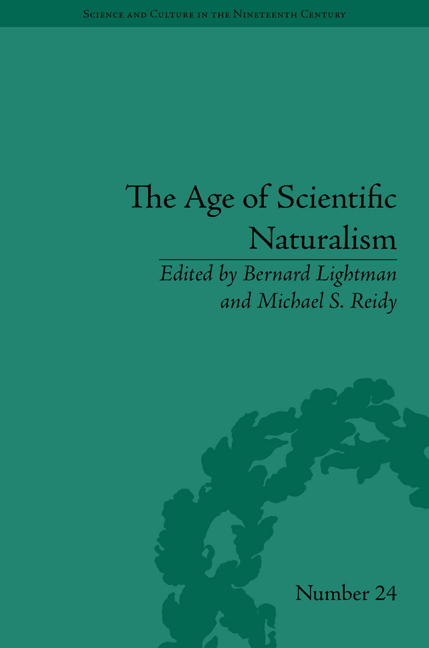Refine search
Actions for selected content:
10306 results in History of science: general interest
CONTENTS
-
- Book:
- The British Arboretum
- Published by:
- Pickering & Chatto
- Published online:
- 05 December 2014, pp vii-viii
-
- Chapter
- Export citation
3 - Agricultural improvement
-
- Book:
- Communities of Science in Nineteenth-Century Ireland
- Published by:
- Pickering & Chatto
- Published online:
- 05 December 2014, pp 71-100
-
- Chapter
- Export citation
7 - ‘I Have in Mind a Study of a Scotch Seaman’: Witnessing Power in Joseph Conrad's Early Literature of the Sea
- from Part III - Science and Technology in Fiction
-
-
- Book:
- Uncommon Contexts
- Published by:
- Pickering & Chatto
- Published online:
- 05 December 2014, pp 145-166
-
- Chapter
- Export citation
CONTENTS
-
- Book:
- James Watt, Chemist
- Published by:
- Pickering & Chatto
- Published online:
- 05 December 2014, pp v-v
-
- Chapter
- Export citation
List of Tables
-
- Book:
- The Aliveness of Plants
- Published by:
- Pickering & Chatto
- Published online:
- 05 December 2014, pp ix-x
-
- Chapter
- Export citation
Notes
-
- Book:
- Communities of Science in Nineteenth-Century Ireland
- Published by:
- Pickering & Chatto
- Published online:
- 05 December 2014, pp 171-198
-
- Chapter
- Export citation
Index
-
- Book:
- Astronomy in India, 1784–1876
- Published by:
- Pickering & Chatto
- Published online:
- 05 December 2014, pp 253-268
-
- Chapter
- Export citation
Frontmatter
-
- Book:
- Brewing Science, Technology and Print, 1700–1880
- Published by:
- Pickering & Chatto
- Published online:
- 05 December 2014, pp i-vi
-
- Chapter
- Export citation
Acknowledgements
-
- Book:
- Communicating Physics
- Published by:
- Pickering & Chatto
- Published online:
- 05 December 2014, pp ix-x
-
- Chapter
- Export citation
Dedication
-
- Book:
- Regionalizing Science
- Published by:
- Pickering & Chatto
- Published online:
- 05 December 2014, pp viii-viii
-
- Chapter
- Export citation
Epigraph
-
- Book:
- Until Darwin, Science, Human Variety and the Origins of Race
- Published by:
- Pickering & Chatto
- Published online:
- 05 December 2014, pp vi-vi
-
- Chapter
- Export citation
List of Figures
-
- Book:
- Uncommon Contexts
- Published by:
- Pickering & Chatto
- Published online:
- 05 December 2014, pp xiii-xiv
-
- Chapter
- Export citation
9 - On Wonder: Situating the Spectacle in Spiritualism and Performance Magic
- from Part III - Staging Knowledge
-
-
- Book:
- Popular Exhibitions, Science and Showmanship, 1840–1910
- Published by:
- Pickering & Chatto
- Published online:
- 05 December 2014, pp 167-182
-
- Chapter
- Export citation
7 - Treatises for the Trade
-
- Book:
- Brewing Science, Technology and Print, 1700–1880
- Published by:
- Pickering & Chatto
- Published online:
- 05 December 2014, pp 157-180
-
- Chapter
- Export citation
Introduction: Ocular Horizons: Vision, Science and Literature
-
- Book:
- Vision, Science and Literature, 1870–1920
- Published by:
- Pickering & Chatto
- Published online:
- 05 December 2014, pp 1-10
-
- Chapter
- Export citation
2 - Getting Past the Greenhouse: John Tyndall and the Nineteenth-Century History of Climate Change
- from Part I - John Tyndall
-
-
- Book:
- The Age of Scientific Naturalism
- Published by:
- Pickering & Chatto
- Published online:
- 05 December 2014, pp 33-50
-
- Chapter
- Export citation

Natural History Societies and Civic Culture in Victorian Scotland
-
- Published by:
- Pickering & Chatto
- Published online:
- 05 December 2014
-
- Book
- Export citation
Introduction
-
- Book:
- Communities of Science in Nineteenth-Century Ireland
- Published by:
- Pickering & Chatto
- Published online:
- 05 December 2014, pp 1-10
-
- Chapter
- Export citation
6 - Professors in the Brewhouse
-
- Book:
- Brewing Science, Technology and Print, 1700–1880
- Published by:
- Pickering & Chatto
- Published online:
- 05 December 2014, pp 135-156
-
- Chapter
- Export citation

The Age of Scientific Naturalism
- Tyndall and his Contemporaries
-
- Published by:
- Pickering & Chatto
- Published online:
- 05 December 2014
-
- Book
- Export citation
